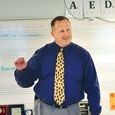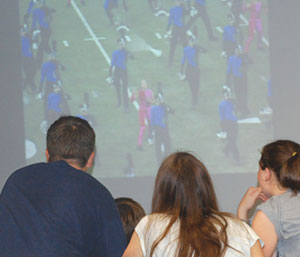 Drive southeast from Rochester, New York about 20 miles this summer, and you’ll be in Blue Devil territory – the Victor High School Marching Blue Devils that is. Just listen from about any place in town and you’ll hear the pulse of street beats and drum cadences cutting through the August heat as the band polishes its performance for the upcoming New York State Field Band Conference season.
Drive southeast from Rochester, New York about 20 miles this summer, and you’ll be in Blue Devil territory – the Victor High School Marching Blue Devils that is. Just listen from about any place in town and you’ll hear the pulse of street beats and drum cadences cutting through the August heat as the band polishes its performance for the upcoming New York State Field Band Conference season.
Eric Everhart directs the 115-member marching band plus color guard and flags, assisted by a staff of 14 people whose time and talents contribute to every aspect of preparing the group to compete. It is a huge commitment that he began 23 years ago as an assistant band director before taking over the entire program in 1996.
“In the 1980s Victor High School was considered a fairly small school,” says Everhart, “we participated in what is now Small School Division Three. In 1989 and 1990 we won back-to-back state championships in that class. Of course, the conference moved us up to Division Two, so in 2000 and 2001 we won back-to-back championships in that division. Next they moved us up to Division One, and in 2006 and 2007 we also won back-to-back championships.
“As luck would have it, at the time we won that second championship the school’s enrollment increased to over 4,000 students, the changing point from small school to large school status in the New York State Field Band Conference. We made a lateral move from Division One for small schools to Division One for large schools and are now competing in New York’s National Class. We are up against some premier organizations that compete on the national level, which is wonderful.”
Lessons in Teamwork
Although the awards are impressive, Everhart says he really doesn’t focus on what place the group takes even though marching band is a competitive activity. “We view the marching band as a way to help students grow. When the staff and I sit down to design programs, we keep in mind that what we put in front of our players and ask them to do should change them as people. They should be much different at the end of the season compared to the beginning of the season. The tag line on our website is Training Students for Life, and the marching band helps them experience that growth.
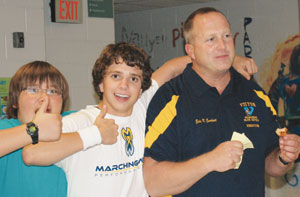
“Some of the lessons from marching band include learning about teamwork and working towards a common goal. For example, the pictures we make on the field require accuracy from everyone. There is no second string, and if just one player doesn’t execute correctly, the entire group suffers. We also encourage students to step up and take responsibility as section leaders. Of course each person in band learns the lesson of supporting the leader. Respecting a stand leader and following directives becomes a crucial part of the overall success of the organization.
Everhart says it is always interesting to watch the players change and mature throughout the season. Early on, new members who haven’t marched gravitate towards other new members. Groups tend to form based on age and gender, but as the season progresses, the groups that formed at the beginning of August are often very different from those that coalesce by the end of the season in October. “It’s as though everyone finds a new common ground as they go through the activity.”
Curricular Versus Extracurricular
Victor High School has curricular groups in the music program, including a wind ensemble and symphonic band, as well as courses in theory and piano; but the marching band is strictly extracurricular. In early April Everhart advertises the date and time of the first practice session, usually in the last week of the month. He puts up recruitment sheets, and students sign up to be part of the group. There are no auditions. The unstated premise is that if a player is ready to come in, work, and do what Everhart asks, then he is in.
“I schedule a handful of practices in spring, usually one per week throughout May and June, to build up our roster. Everyone takes the month of July off, and then the students come back in August for camp week, although it’s not an official camp. The students come every day, Monday through Friday, for eight hours to learn the show for the new school year.
“A show that lasts approximately seven-and-a-half minutes will include three pieces of music with about 80 pictures or drill sets. Students make 80 different formations for the program that we march for the New York State Field Band Conference.” The marching band travels to different locations each Saturday and competes against different bands in its division. They have their own circuit and their own competitions. Marching for weekend football games is not the band’s main activity.
An Amazing Team
While Everhart works with 14 part-time people on the marching band staff, he is the only official employee. Everyone who helps is a professional in areas other than education. “My visual designer builds web sites, and the person who writes all the drum scores works for Blue Cross, Blue Shield health care. Most of the staff members were once in drum corps so they have had marching experience. I’ve been fortunate in that people come to me offering to help; I’ve never had to go out and recruit for staff.”
Right after marching season in November or December, Everhart and three or four of his staff get together and talk through the various new ideas for show designs. They usually have a half dozen ideas kicking around as they try to anticipate the band’s instrumentation and membership for the next year.
“The drill moves are the vision of the design person. We talk through them as a team, often asking him whether certain ideas will work in terms of the visual pictures the band is making when combined with the music. He is a musician so that is helpful. Once we decide on the drill, arranging the music is next so we can get parts out to the students.”
As director of the ensemble, Everhart contacts the music publishing companies whose pieces the band will perform and asks permission to adapt the music specifically for the Blue Devils. This involves entering into a contract with each company for which the band boosters organization pays a fee. For several years he hired an arranger in Indianapolis, and this year his visual designer has arranged the band’s music.
Learning The Show
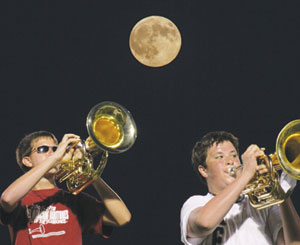 In the spring Everhart rehearses the band to the point where everyone knows his part. Even for the first summer rehearsals, they focus on the music, eventually memorizing the entire show. “Next we begin to teach the drill based on chunks of musical phrases and how the visual picture lays out. Any changes of direction in the drill are based on musical phrases. On the first day we may teach the drill based on the beginning of the opener, the first piece, up to letter B. The students will know the music well enough by then to go through the music phrase by phrase with the pictures they are making, practicing them together.
In the spring Everhart rehearses the band to the point where everyone knows his part. Even for the first summer rehearsals, they focus on the music, eventually memorizing the entire show. “Next we begin to teach the drill based on chunks of musical phrases and how the visual picture lays out. Any changes of direction in the drill are based on musical phrases. On the first day we may teach the drill based on the beginning of the opener, the first piece, up to letter B. The students will know the music well enough by then to go through the music phrase by phrase with the pictures they are making, practicing them together.
“Technology has stepped in and made marching band so much easier for the students. The drill sets are created with a program called Pyware for writing the drill that includes printed copies of each entire picture for the students. They get to see the same movements and changes the staff sees, not just their spot. We teach it, and they can see where they are in each picture.
“We also use Pyware in combination with Finale digital music files by running the drill and the music through a projector so students can see the entire show when band camp begins in August. It’s seven-and-a-half minutes of marching combined with the music. It’s wonderful. It has been a powerful tool for us.”
With a laugh, Everhart recalls a rehearsal from about three years ago when the band was training with wireless mics. One day he found himself in line with an unexpected audio signal, and suddenly everyone started hearing a Canadian television broadcast coming through the sound system. The Blue Devils ended up listening to Canadian television for about five minutes before the rehearsal could resume. The band simply couldn’t do anything.
Concert Band Versus Marching Band
Does marching band take away from concert band? Everhart’s view is that the marching band is a wind ensemble that happens to march. “The wind ensemble is our focus, and the visual piece comes later. We don’t place more emphasis on the visual with the music only tagging along for the ride. Music is the main focus of everything the marching band does.
“There are also pragmatic considerations. Marching 80 pictures in seven-and-a-half minutes is a much different challenge when it comes to breathing and support because it’s done standing up, not sitting in a chair. From a practical standpoint, at the end of the season the marching band students are making much bigger and better sounds than the students who don’t march.
“I work hard to make sure the marching band does not affect the indoor programs and that the indoor programs remain central to the music department. For example, students can be in marching band, only if they are first enrolled in the school’s curricular music program. Students don’t get the high level of training necessary to be a good musician by just being in marching band.”
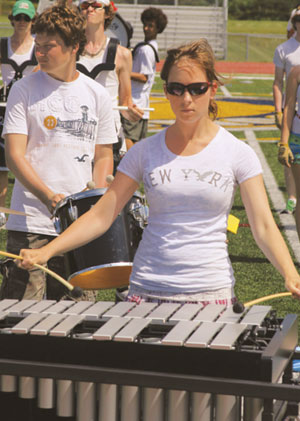
Extraordinary Boosters
The Victor Band Boosters help the music department by sponsoring summer music lessons for students. This includes hiring instructors and devising a schedule for the district. The program began when the visual designer, Mark Rider, realized the need for more practice time in summer because students finished up the school year in June, then did not touch an instrument again until September.
Parents who want lessons for their children pay for them through the band boosters. At this point it is a relatively young program, but it has made a big difference in the abilities of each student.
Fundraising is another vital function of the band boosters with this organization providing huge sums of money for the group. “This year the goal was to raise $45,000. When I joined the program in 1987, the group raised about $6,000 annually, and now it averages anywhere from $40,000 to $55,000.
“While the school is supportive, providing funds for transportation and two sets of uniforms, the administration can’t cover everything. The band boosters step in by supplementing staff salaries so that we can have more qualified staff.
“Four of us ran the entire show 23 years ago, and now I have a staff of 14 who work with the marching program. Some receive a stipend through the school and some through the band boosters. That has been the biggest difference – the number of adults and the depth of their expertise. This has become necessary because training now is much more specialized.”
Everhart’s favorite fundraising project is a annual silent auction that takes place at a local country club. “It’s a nice event with the fun of making silent bids on different items. It’s also a chance to see and talk to the many former band parents who attend. As a director it is wonderful to see all these people coming together to support our programs.”
Sage Advice
What has helped Everhart most in the last 10 years is remembering to stay focused on the students. “I think we can get so caught up in marching band that it begins to dominate our lives. I try to impress on my staff that students are involved in a lot of activities. I suggest they ask students about what else they do and remember that marching band is simply one part of their lives. We all like to think our activity is the most important, but it is not necessarily the most important thing to students. When I speak to students, I often find that the other aspects of their lives are quite interesting.”
